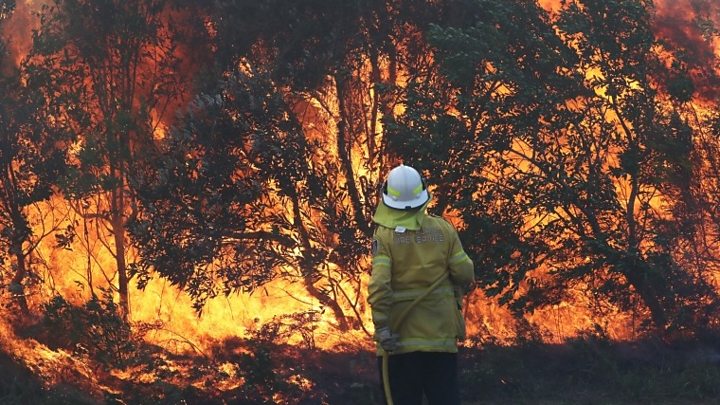SYDNEY (Reuters) - Australian Prime Minister Scott Morrison issued a rare public apology on Friday and cut short a Hawaiian vacation in response to mounting public anger after two volunteer firefighters were killed battling bushfires sweeping the country’s east coast.
Flowers and the helmets of volunteer firefighters Andrew O'Dwyer and Geoffrey Keaton, who died when their fire truck was struck by a falling tree as it traveled through the front line of a fire, are seen at a memorial at the Horsley Park Rural Fire Brigade in Horsley Park, NSW, December 20, 2019. AAP Image/Bianca De Marchi/via REUTERS
Some areas of Sydney are set for “catastrophic” conditions on Saturday, and the deadly fires are now engulfing other parts of the country. One person was killed in a car crash on Friday near South Australia’s capital city of Adelaide where an emergency warning is in place, though the precise circumstances surrounding the death is not yet clear.
Australia has been fighting wildfires across three states for weeks, with blazes destroying more than 700 homes and nearly 3 million acres (1.2 million hectares) of bushland.
The death of the two firefighters overnight when their fire truck was struck by a falling tree as it traveled through the front line of a fire brought the fires death toll in New South Wales to eight since the start of October.
Ten more firefighters were seriously injured on Thursday, with four in South Australia being treated for burns and smoke inhalation.
“The worst imaginable set of circumstances unfolded,” New South Wales (NSW) Rural Fire Service (RFS) Commissioner Shane Fitzsimmons told reporters in Sydney. “This hurts everybody to the core.”
Shortly after the pair’s deaths were announced, Morrison issued a statement saying he would return as soon as possible from a family holiday in Hawaii, a trip that has drawn sharp criticism in recent days as the wildfires crisis deepened.
“I deeply regret any offence caused to any of the many Australians affected by the terrible bushfires by my taking leave with family at this time,” Morrison said in the statement.
Morrison later told 2GB radio that the trip had been planned as a surprise to his young daughters to replace leave originally scheduled for January that he had canceled because of official trips to Japan and India.
CATASTROPHIC FIRE HAZARD
His return comes as firefighters prepare for “catastrophic” fire danger - the most severe level - in NSW on Saturday as searing heat and high winds are forecast, leading officials to urge people to evacuate their homes early if they live close to bushland.
“It is a fairly strong likelihood that we will lose homes tomorrow, it would be a miracle if we don’t,” RFS Deputy Commissioner Rob Rogers told reporters in Sydney.
There are more than 200 fires burning across Australia - 70 of which are classified as uncontrolled, mostly in NSW.
In South Australia, more than 120 blazes have broken out in catastrophic conditions. Bracing for more potential fatalities, authorities said an emergency fire in Lameroo, 210 km (130.5 miles) east of Adelaide may pose a threat to lives directly in its path and urged residents to flee now.
Morrison’s conservative Liberal-National coalition government has been under sustained pressure to defend its climate change policies as it has downplayed links to the unprecedented early arrival and severity of this year’s bushfire season.
Hundreds of protesters gathered outside Morrison’s Sydney residence on Thursday. One protestor, wearing an Hawaiian shirt, carried a sign reading, “ScoMo, where the bloody hell are you?” referencing the leader’s nickname and a well-known international advertisement for Tourism Australia.
Australia is one of the world’s largest carbon emitters per capita because of its reliance on coal-fired power plants. It has pledged to cut carbon emissions by 26% from 2005 levels by 2030, but critics accuse Morrison of paying lip service to that commitment.
In June, the government approved the construction of a new coal mine in Queensland state by India’s Adani Enterprises that is expected to produce 8 million to 10 million tonnes of thermal coal a year.
As Morrison was apologizing on radio on Friday morning, opposition Labor Party leader Anthony Albanese was serving breakfast to firefighters near the front line of a fire in rural Bilpin.
CHRISTMAS TRAVEL WARNING
The fires have resulted in days of heavy pollution in Sydney, pushing air quality to unprecedented hazardous levels and resulting in viral images of heavy smoke haze over the usually sparkling harbor and landmarks like the Opera House.
The fires are being spurred this week, by record temperatures across the country which led NSW, the most populous state with 7 million people, to declare a seven-day state of emergency.
Thursday’s declaration gave firefighters broad powers to control government resources, force evacuations, close roads and shut down utilities.
Days out from Christmas, a time when many Australians head to the coast for the holidays, NSW Premier Gladys Berejiklian urged people to reconsider travel plans.
“What is most important for us is that everyone is safe and if that means changing your plans for Christmas, we ask you do to that,” Berejiklian told reporters in Sydney.
(GRAPHIC: Forests in flames: Images from space show Australia's bushfires in different light - here)
Additional reporting by Swati Pandey; Editing by Jane Wardell & Shri Navaratnam
https://news.google.com/__i/rss/rd/articles/CBMikAFodHRwczovL3d3dy5yZXV0ZXJzLmNvbS9hcnRpY2xlL3VzLWF1c3RyYWxpYS1idXNoZmlyZXMvYXVzdHJhbGlhbi1wbS1hcG9sb2dpemVzLWZvci12YWNhdGlvbi1hcy1maXJlZmlnaHRlcnMta2lsbGVkLWluLWh1Z2UtYmxhemVzLWlkVVNLQk4xWU4yUTPSATRodHRwczovL21vYmlsZS5yZXV0ZXJzLmNvbS9hcnRpY2xlL2FtcC9pZFVTS0JOMVlOMlEz?oc=5
2019-12-20 05:58:22Z
CBMikAFodHRwczovL3d3dy5yZXV0ZXJzLmNvbS9hcnRpY2xlL3VzLWF1c3RyYWxpYS1idXNoZmlyZXMvYXVzdHJhbGlhbi1wbS1hcG9sb2dpemVzLWZvci12YWNhdGlvbi1hcy1maXJlZmlnaHRlcnMta2lsbGVkLWluLWh1Z2UtYmxhemVzLWlkVVNLQk4xWU4yUTPSATRodHRwczovL21vYmlsZS5yZXV0ZXJzLmNvbS9hcnRpY2xlL2FtcC9pZFVTS0JOMVlOMlEz








